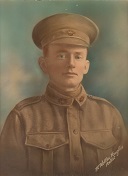Pte
Frederick William Olsen
Informations sur naissance
|
Date de naissance: 21/09/1886 |
|
Lieu de naissance: Nambour, Queensland, Australia |
Informations générales
|
Profession: Ouvrier |
Informations service militaire
|
Pays: Australia |
|
Force armée: Australian Imperial Force |
|
Rang: Private |
|
Numéro de service: 2484A |
|
Incorporation nom de lieu: Bundaberg, Queensland, Australia |
|
Unités: — Australian Infantry, 47th Bn. (Dernière unité connue) |
Informations sur décès
|
Date de décès: 12/10/1917 |
|
Lieu de décès: Decline Copse, Passchendaele, Belgique |
|
Cause du décès: Killed in action (K.I.A.) |
|
Âge: 31 |
Cimetière
|
Poelcapelle British Cemetery Parcelle: VII Rangée: E Tombe: 1 |
Distinctions et médailles 2
|
British War Medal Médaille |
|
Victory Medal Médaille |
Points d'intérêt 3
| #1 | Lieu de naissance | ||
| #2 | Lieu d'enrôlement | ||
| #3 | Lieu du décès (approximatif) |
Mon histoire
Private Frederick Olsen served in the 47th Battalion Australian Infantry, part of the 12th Brigade of the 4th Australian Division. On October 12, the 12th Australian Brigade fought in the First Battle of Passchendaele, one of the final phases of the Third Battle of Ypres.
On October 12, the 12th Brigade was ordered to protect the right flank of the 3th Australian Division, which was the main force, with the village of Passchendaele as its objective. The 47th Battalion attacked in the early morning with the 48th in their rear. The 9th Brigade to the left started the attack behind them, forcing the 48th to defend their left flank as well. Because of this and the heavy fighting, the two battalions of the 12th got intermingled. They reached their objective and after consolidation, a large German counterattack, of about 1000 soldiers strong, advanced towards the right flank, held by the 47th. They repelled the counterattack with artillery and machinegun fire. A second counterattack followed during which a SOS signal was sent for an artillery barrage. No artillery shells were fired but the German attack was repelled by heavy machinegun and rifle fire. Because the 9th Brigade, 3th Australian Division on the left failed to advance and retired, the 47th and 48th had to retreat to the initial frontline.
Private Olsen’s body was found near Decline Copse in the vicinity of the railway, which was the boundary between the 3th and 4th Australian Division. The exact circumstances of his death are unknown, but he probably fell either during the early attack, when the 47th was advancing towards the first objective, or when they were retreating in the afternoon. In 1923, private Olsen’s remains were reinterred on the Poelcapelle British Cemetery.
On October 12, the 12th Brigade was ordered to protect the right flank of the 3th Australian Division, which was the main force, with the village of Passchendaele as its objective. The 47th Battalion attacked in the early morning with the 48th in their rear. The 9th Brigade to the left started the attack behind them, forcing the 48th to defend their left flank as well. Because of this and the heavy fighting, the two battalions of the 12th got intermingled. They reached their objective and after consolidation, a large German counterattack, of about 1000 soldiers strong, advanced towards the right flank, held by the 47th. They repelled the counterattack with artillery and machinegun fire. A second counterattack followed during which a SOS signal was sent for an artillery barrage. No artillery shells were fired but the German attack was repelled by heavy machinegun and rifle fire. Because the 9th Brigade, 3th Australian Division on the left failed to advance and retired, the 47th and 48th had to retreat to the initial frontline.
Private Olsen’s body was found near Decline Copse in the vicinity of the railway, which was the boundary between the 3th and 4th Australian Division. The exact circumstances of his death are unknown, but he probably fell either during the early attack, when the 47th was advancing towards the first objective, or when they were retreating in the afternoon. In 1923, private Olsen’s remains were reinterred on the Poelcapelle British Cemetery.
Sources 6
|
12th Australian Infantry Brigade, (Australian War Memorial, Campbell (AWM), AWM4 23/12/20). https://www.awm.gov.au/collection/C1338583 Sources utilisées |
|
47th Australian Infantry Battalion, (Australian War Memorial, Campbell (AWM), AWM4 23/64/17). https://www.awm.gov.au/collection/C1338583 Sources utilisées |
|
Australian War Memorial https://www.awm.gov.au/ Sources utilisées |
|
C. E. W. Bean, Official History of Australia in the War of 1914-18 Vol. IV The A.I.F. in France 1917, (Sydney, Angus and Robertson Ltd., 1943), p 923-6. Sources utilisées |
|
First Australian Imperial Force Personnel Dossiers, 1914-1920, (National Archives of Australia, Canberra (NAA), B2455, OLSEN F). https://recordsearch.naa.gov.au/SearchNRetrieve/Interface/SearchScreens/NameSearch.aspx. Sources utilisées |
|
McCarthy C., The Third Ypres Passchendaele. The Day-by-Day Account, (London, Arms & Armour Press, 1995), pg. 113-4. Sources utilisées |
Complément d’informations 4
|
Commonwealth War Graves Commission Database https://www.cwgc.org/find-records/find-war-dead/casualty-details/491938 |
|
Namenlijst (In Flanders Fields Museum) https://namenlijst.org/publicsearch/#/person/_id=dc53baf0-f044-44f7-ac2d-208906b3ab04 |
|
Lives of the First World War (Imperial War Museum) https://livesofthefirstworldwar.iwm.org.uk/lifestory/7530978 |
|
The AIF Project (UNSW Canberra) https://aif.adfa.edu.au/showPerson?pid=230306 |
